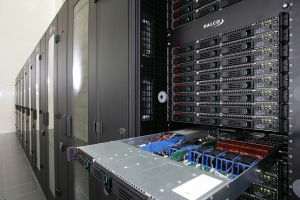 |
| IBM Blue Gene Supercomputer |
During the course of our lives we use to hear a lot about supercomputers. But do we really know what all is this about? What is a supercomputer? What are their key characteristics? How are they different from our ordinary personal computers?
I will start by saying that a supercomputer is just a different type of computer; a computer that holds way higher computing power than the regular ones. However, this overwhelming computing power does not come without a price tag. A supercomputer consumes a great deal of power (in the order of KWatts or MWatts), contains really expensive components (in the order of millions of dollars) and requires enormous amounts of space in order to accommodate, not only the computer components themselves, but also all the infrastructure that is needed for power and cooling.
After the concise definition of supercomputer we gave in the introductory paragraph, I guess we all wonder: How is it possible to obtain a computing power that is a hundred or a thousand times better than our desktop PCs using the existent microprocessor technology? The answer to this question lies in the huge computing power that can be achieved by taking advantage of a technique known as "massive parallel processing". Any supercomputer is made-up of hundreds or even thousands of smaller computers called nodes. Similarly, each node contains a set of multi-core processors that are capable of addressing large amounts of memory. Supercomputer nodes are generally designed in a slim form factor so they can be physically arranged inside vertical racks to form clusters. The next two pictures show the appearance of a node, and also the way how they are arranged inside the racks.
 |
| Supercomputer node |
 |
| Supercomputer nodes arranged inside racks |
A supercomputer requires a special cooling system consisting of a complex air conditioner array. The function of this cooling system is to keep the temperature of the nodes cold so they can work optimally. It is evident that the power consumption of the cooling system represents a significant contribution to the total power consumption of the whole supercomputer.
Now that we know the basics about supercomputers let us explore their applications. The supercomputers are used for scientific research such as in complex physics and biological simulations. Such applications take enormous advantage of massive parallel processing of supercomputers.
Let us enumerate some specific examples of supercomputing applications:
- Climate modeling; Using supercomputers researchers can model past, present and predict future climate.
- Space simulation: By using supercomputer space researcher are able to study the behavior of the sun, the stars and the space in general.
- Supercomputers are used to simulate the effects of a tsunami over any given city or coast.
- Supercomputers are used to simulate supernovas explosions
- Supercomputers are used to test the aerodynamics of the most advanced military aircrafts
- Supercomputers allow simulating protein folding, and how this folding can affect people suffering Alzheimer disease, and also many types of cancer.
- Supercomputers are used to simulate nuclear explosions, eliminating the need of performing real nuclear tests.[3]
In this article we have learned about supercomputers, their characteristics, applications and physical appearance. It is evident that supercomputers have been really important tools for the advancement of science and technology. In spite of their high cost, even more powerful supercomputers will continue to be designed and developed because without them it would be nearly impossible to solve many of the critical scientific problems of the human kind.
REFERENCIAS
[1]http://en.wikipedia.org/wiki/FLOPS
[2] http://www.fujitsu.com/global/about/tech/k/
[3] http://es.wikipedia.org/wiki/Supercomputadora

0 comments:
Speak up your mind
Tell us what you're thinking... !